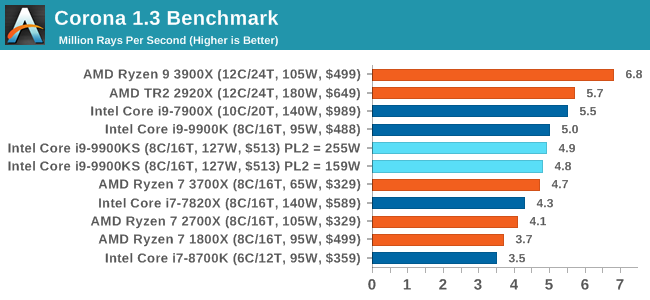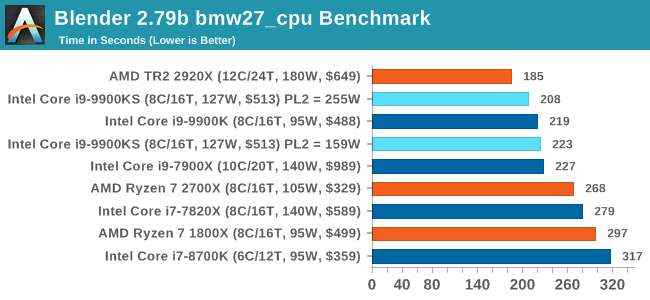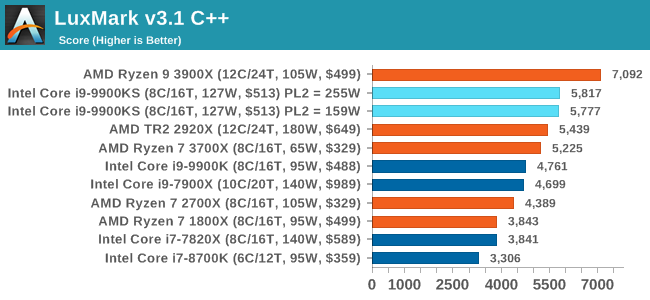The Intel Core i9-9900KS Review: The 5 GHz Consumer Special
by Dr. Ian Cutress on October 31, 2019 10:45 AM ESTCPU Performance: Rendering Tests
Rendering is often a key target for processor workloads, lending itself to a professional environment. It comes in different formats as well, from 3D rendering through rasterization, such as games, or by ray tracing, and invokes the ability of the software to manage meshes, textures, collisions, aliasing, physics (in animations), and discarding unnecessary work. Most renderers offer CPU code paths, while a few use GPUs and select environments use FPGAs or dedicated ASICs. For big studios however, CPUs are still the hardware of choice.
All of our benchmark results can also be found in our benchmark engine, Bench.
Corona 1.3: Performance Render
An advanced performance based renderer for software such as 3ds Max and Cinema 4D, the Corona benchmark renders a generated scene as a standard under its 1.3 software version. Normally the GUI implementation of the benchmark shows the scene being built, and allows the user to upload the result as a ‘time to complete’.
We got in contact with the developer who gave us a command line version of the benchmark that does a direct output of results. Rather than reporting time, we report the average number of rays per second across six runs, as the performance scaling of a result per unit time is typically visually easier to understand.
The Corona benchmark website can be found at https://corona-renderer.com/benchmark

Interestingly both 9900KS settings performed slightly worse than the 9900K here, which you wouldn't expect given the all-core turbo being higher. It would appear that there is something else the bottleneck in this test.
Blender 2.79b: 3D Creation Suite
A high profile rendering tool, Blender is open-source allowing for massive amounts of configurability, and is used by a number of high-profile animation studios worldwide. The organization recently released a Blender benchmark package, a couple of weeks after we had narrowed our Blender test for our new suite, however their test can take over an hour. For our results, we run one of the sub-tests in that suite through the command line - a standard ‘bmw27’ scene in CPU only mode, and measure the time to complete the render.
Blender can be downloaded at https://www.blender.org/download/

All the 9900 parts and settings perform roughly the same with one another, however the PL2 255W setting on the 9900KS does allow it to get a small ~5% advantage over the standard 9900K.
LuxMark v3.1: LuxRender via Different Code Paths
As stated at the top, there are many different ways to process rendering data: CPU, GPU, Accelerator, and others. On top of that, there are many frameworks and APIs in which to program, depending on how the software will be used. LuxMark, a benchmark developed using the LuxRender engine, offers several different scenes and APIs.
In our test, we run the simple ‘Ball’ scene on both the C++ and OpenCL code paths, but in CPU mode. This scene starts with a rough render and slowly improves the quality over two minutes, giving a final result in what is essentially an average ‘kilorays per second’.

Both 9900KS settings perform equally well here, and a sizeable jump over the standard 9900K.
POV-Ray 3.7.1: Ray Tracing
The Persistence of Vision ray tracing engine is another well-known benchmarking tool, which was in a state of relative hibernation until AMD released its Zen processors, to which suddenly both Intel and AMD were submitting code to the main branch of the open source project. For our test, we use the built-in benchmark for all-cores, called from the command line.
POV-Ray can be downloaded from http://www.povray.org/

One of the biggest differences between the two power settings is in POV-Ray, with a marked frequency difference. In fact, the 159W setting on the 9900KS puts it below our standard settings for the 9900K, which likely had an big default turbo budget on the board it was on at the time.











235 Comments
View All Comments
mattkiss - Friday, November 1, 2019 - link
The Processor Specification field in the CPU-Z screen shot has "(ES)" after the cpu name. Did you test and engineering sample or an actual retail sample?GreenReaper - Sunday, November 3, 2019 - link
It was only launched a couple of days ago, so they'd have to have had a sample, you couldn't run the tests and write the article having bought it at retail.BAF2782 - Friday, November 1, 2019 - link
Nice to see a 10+year old Thermalright True Copper: 2kg for a CPU that has a mini-nuclear thermal reactor powering itself. LoL. I can't really say much. I'm using a 11year old ZALMAN CNPS 9900MAX (300watt) AIR cooler on a 5.3GHz Golden 8700K with 1.380v in a z370 Aorus Gaming 7. I thought about getting a new cooler with the $400 open-box 9900K that i just found. But, after seeing the 9900KS running on the 10year old Thermalright True Copper: 2 kg. I don't have a doubt the ZALMAN 9900MAX (300watt) cooler will have any problems running a 5GHz (PO) 9900K.crotach - Saturday, November 2, 2019 - link
So, this is a direct competitor to 2700X, but costs twice as much?I wonder if we'll see intel as a budget offering in a couple of years, cutting the price of their 14nm tech to half of what AMD charges just to get some sales.
My my, how the tables have turned :)
Dragonstongue - Saturday, November 2, 2019 - link
if they can say 4ghs base, but 5ghz all core turbo, why not just have as 5ghz directly ??I confused, seems another marketing ploy of some sort (no real surprise there)
that being said, likely good for AMD as well as sets a new target for them TSMC et al.
Orkiton - Saturday, November 2, 2019 - link
It's like a Caterpillar engine that will need hydrogen fuel to beat most benchmarks. That means expensive Mobo, GPU, PSU, Mem, Cooler, Case.It's Intel stretching to the limits for PR purposes, yet much bellow AMD, in terms of value for money.
liquid_c - Sunday, November 3, 2019 - link
It's unbelievable, i swear. Even Anandtech's comment section has turned into a pcgamer shit show. Instead of just trying to take the article as it is - a piece of info, most of the people here either start a revolution against Intel or just plain dismiss it as "fake information" in regards to TDP. But i see nobody here admitting that Intel's 14nm is ON PAR with AMD's 7nm (i've heard they have the same density but don't quote me on that). Or that said products is not geared towards you or your acquaintances. I swear to God, it's like Intel has raped some family member or something. Just buy whatever you think is fit for you and leave others to enjoy proper journalism (which is so f*cking rare nowadays).liquid_c - Sunday, November 3, 2019 - link
*are not geared.Sigh, i miss an edit button :(
Korguz - Sunday, November 3, 2019 - link
cause it is fake info, 127 watts ?? nope, 200+ more then likely. and some i think, are tired of the lies, BS, and over charging intel has had us pay over the years. face it, if amd didnt bring out zen, the chances are we would still be stuck at quad core for the mainstream, and anything above that, would be HEDT. FYI, it may be on par, but intel should also be on 10nm by now... maybe even the next node size, and yet, intel kept saying, 10nm is on track. there are better, less expensive options then this cpu, this is just intel being intel, last ditch effort to try to save face.The Garden Variety - Sunday, November 3, 2019 - link
Thank you, liquid_c. This needs to be repeated over and over again. You have this stellar quality content, painstakingly researched and presented, and it's clear many of the readers (or at least the ones that comment) are neither understanding it, reading it in context, or even trying to think about it. The smartphone reviews are identical. It's all just "how do I read what I want so I can wage my emotional holy war because I have literally nothing else going for me."Here, I'll go one step further: there's zero reason for a site like Anandtech to have comments following articles at all. You could delete 9 out of 10 attached to this article and zero of value would be lost. Given how terribad the comment system is (no editing, tiny and unscalable input window, spam posts that go undetected for days, etc.) and the effort/investment it would likely take Anandtech's limited team to improve it, just getting the hell rid of it would be a far more sensible solution. Let the content be the star. Send people to the forums in a special board requiring a 500 post barrier in the broader community to contribute to article discussions.